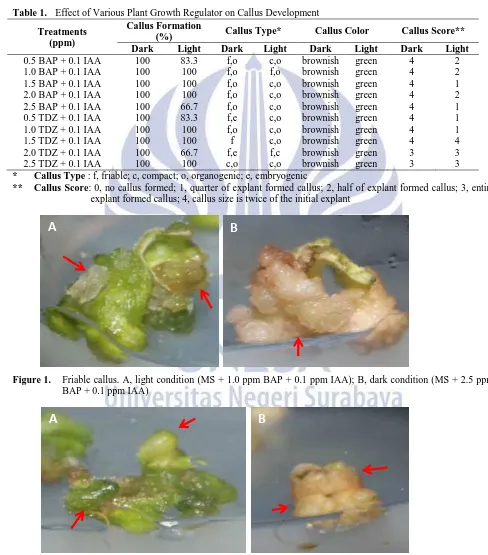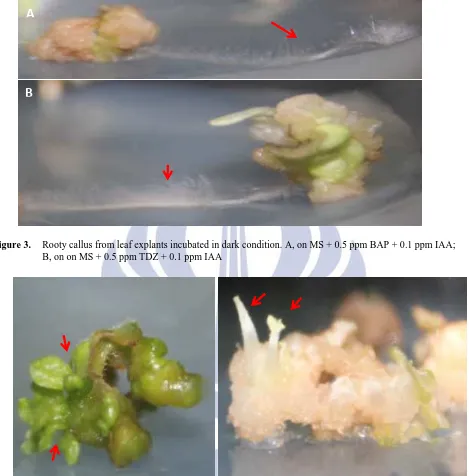CALLUSES FROM TOMATO CV. TYMOTI AND THEIR MORPHOLOGICAL
CHARACTERISTICS AS SUPPORTING MATERIAL
FOR PLANT TISSUE CULTURE LESSON
W.D. Savitri, A.B. Ferina, Y. Octavia, E. Muliawan, E.E. Effendi
Department of Biology, Faculty of Biotechnology, University of Surabaya
Jalan Raya Kalirungkut Surabaya 60292, East Java, Indonesia. Phone/fax: (031) 2981399/1278 winasavitri@staff.ubaya.ac.id
ABSTRACT
Plant tissue culture is one of interesting and important lessons in Department of Biology, Faculty of Biotechnology, University of Surabaya. Unfortunately, many students do not understand enough of what actually callus is. They also do not have sufficient understanding about callus types. The problem probably arises from the lack information about callus types in a real photograph. This experiment was conducted by students, aimed to produce callus from leaf explants of tomato cv. Tymoti by using benzylaminopurine (BA) and thidiazuron (TDZ) (0.5-2.5) ppm, each of which was combined with 0.1 ppm indoleacetic acid (IAA). After five weeks, the various types of callus were morphologically characterized and the photographs were collected. The photographs will be used as supporting materials in plant tissue culture lesson.
Keywords: callus types, tomato cv. Tymoti, BA, TDZ, IAA
INTRODUCTION
As one of the interesting applied subjects in Department of Biology, Faculty of Biotechnology, University of Surabaya, plant tissue culture is needed to be understood by students. Unfortunately, students oftenly have difficulty in characterizing callus morphology, since the information about callus types in a real photograph is limited. To date, the sources of callus photograph were mostly provided from journals and text books.
Callus is unorganized mass of proliferating cells found in in vivo and in vitro plants. In a normal condition (in vivo), plants develop callus due to the wound healing process, while in in vitro condition, it is only produced if growth regulator is added to the culture medium. In vitro callus has some purposes, i.e. to produce cell culture, as research materials for plant transformation and produce new plants through indirect regeneration pathway.
In plant biotechnology, tomato is a model organism which frequently used because of its short life cycle (Nath et al, 2014) and have already known genetically (The tomato genome consortium, 2012). In this research tomato is used because its easiness to regenerate and induce by using plant growth regulator (PGR). The attempts to induce callus have been conducted from different tomato explants and various PGR, namely 0.5 ppm 2,4-D from nodal segments (Jehan and Hassanein, 2013), 0.5 ppm NAA from hypocotyls
(Osman et al, 2010), and 1 ppm BAP + 1 ppm NAA from anther explants (Brasileiro,1999).
This experiment objected to compare callus types induced by BAP, TDZ and IAA. Moreover, this also aimed to characterize the callus based on its morphological feature. The information will be very useful as supporting material for plant tissue culture condition, they were excised 0.5x0.5 cm2 in size. The leaf discs were subsequently cultured on to culture media.
Culture media
MS basal medium containing 3% sucrose and 100 mg myoinositol solidified with 0.8% agar (basal mixture) was used. As much as 1 ppm IAA was added to the basal autoclaved at 121ºC, 1.5 atm for 20 minutes.
Every treatment was conducted in a series of 4 bottles and each bottle contained 3 explants. Each treatment was divided into two culture conditions, i.e. dark condition (24h dark) and light condition (16h light period per day). Incubator was set at 23 ± 2ºC and 80% humidity. The light intensity was regulated at 1.000 lux with 16/8 h (light/dark) cycle. The development of callus
were observed and photographed after 5 weeks of incubation.
Photograph collection and characterization of callus
Calluses were photographed with Canon EOS 60D 18-55 mm. The photographs were then characterized based on the morphological features, i.e. compact, friable, embryonic, and organogenic (shooty and rooty).
RESULTS
Table 1. Effect of Various Plant Growth Regulator on Callus Development
Treatments (ppm)
Callus Formation
(%) Callus Type* Callus Color Callus Score**
Dark Light Dark Light Dark Light Dark Light
0.5 BAP + 0.1 IAA 100 83.3 f,o c,o brownish green 4 2 1.0 BAP + 0.1 IAA 100 100 f,o f,o brownish green 4 2 1.5 BAP + 0.1 IAA 100 100 f,o c,o brownish green 4 1 2.0 BAP + 0.1 IAA 100 100 f,o c,o brownish green 4 2 2.5 BAP + 0.1 IAA 100 66.7 f,o c,o brownish green 4 1 0.5 TDZ + 0.1 IAA 100 83.3 f,e c,o brownish green 4 1 1.0 TDZ + 0.1 IAA 100 100 f,o c,o brownish green 4 1 1.5 TDZ + 0.1 IAA 100 100 f c,o brownish green 4 4 2.0 TDZ + 0.1 IAA 100 66.7 f,e f,c brownish green 3 3 2.5 TDZ + 0.1 IAA 100 100 c,o c,o brownish green 3 3
* Callus Type : f, friable; c, compact; o, organogenic; e, embryogenic
** Callus Score: 0, no callus formed; 1, quarter of explant formed callus; 2, half of explant formed callus; 3, entire
explant formed callus; 4, callus size is twice of the initial explant
Figure 1. Friable callus. A, light condition (MS + 1.0 ppm BAP + 0.1 ppm IAA); B, dark condition (MS + 2.5 ppm
BAP + 0.1 ppm IAA)
Figure 2. Compact callus. A, light condition (MS + 1.0 ppm TDZ + 0.1 ppm IAA); B, dark condition (MS + 2.5 ppm
TDZ + 0.1 ppm IAA)
B
A
Figure 3. Rooty callus from leaf explants incubated in dark condition. A, on MS + 0.5 ppm BAP + 0.1 ppm IAA;
B, on on MS + 0.5 ppm TDZ + 0.1 ppm IAA
Figure 4. Shooty callus. A, light condition (MS + 2.5 ppm TDZ + 0.1 ppm IAA); B, dark condition (MS + 1.5 ppm
BAP + 0.1 ppm IAA)
Figure 5. Embryonic callus from leaf explant cultured in dark condition (MS + 0.5 ppm TDZ + 0.1 ppm IAA)
B
DISCUSSION
All treatments incubated in dark condition successfully resulted maximum callus formation (100%). However, cultures in light condition produced lower frequency (66.7-83.3%) due to contamination. If the contamination could be avoided, there was a probability to achieve 100% callus frequency as well because the explants already showed response but no callus formed yet. So it was likely that there was no correlation between lower callus frequency and treatment in light condition.
Friable callus mostly produced in dark condition, whereas compact callus were more frequent on cultures incubated in light condition. Friable and compact callus are calluses which do not exhibit any obvious organ (Ikeuchi et al, 2013). They are differ physically, that friable callus is soft, fragile and watery, while compact callus is hard (Akaneme and Eneobong, 2008). In this research, friable and compact callus is shown on Figure 1 and 2. In dark condition, callus color was brownish, when it was green in light condition. This fact indicated that no chlorophyll produced on cultures incubated in dark condition. Moreover, callus score was higher on cultures incubated in dark than in light condition. Callus score showed the growth of callus compared to the size of initial explants. This result is inline with Jaramillo and Summers (1991) that callus induced from anther explants increased in diameter and number as the increase of dark period.
Almost all of the treatments produced organogenic callus. Organogenic callus is callus that shows distinct organ, i.e. root (rooty callus) or shoot (shooty callus) (Ikeuchi et al, 2013). Organogenic callus, in this study, was found frequently on both cultures incubated in dark and light condition. Figure 3 shows rooty callus in dark and light condition and shooty callus is as shown on Figure 4. Embryonic callus is callus which bears embryo-like structure (Ikeuchi, 2013). However, embryonic callus was only observed on cultures incubated in dark condition and only on cultures treated with TDZ (0.5 ppm and 1 ppm) in combination with 0.1 ppm IAA. Figure 5 shows embryogenic callus from explant cultured in 0.5 ppm TDZ + 0.1 ppm IAA. TDZ was reported to induce somatic embryogenesis in some species. Zhou et al (1994) reported the application of TDZ combined with naphthalene acetic acid (NAA) to induce somatic embryo from ovary explants of Cayratia japonica. TDZ induces somatic embryogenesis in peanut by accumulating the endogenous cytokinins (Murthy et al, 1995). Yet in tomato cv. Omdurman, TDZ was known as the inducer to produce high frequency of shoot formation (Osman et al, 2010).
The characterization of callus morphology was hardly accomplished only by naked eye. Stereo microscope was needed to make sure that a callus feature was actually an organ primordia or an embryo primordia. Furthermore, high resolution of image was also helpful to characterize the callus types. In this case, callus types could obviously observed only after the photographs were taken.
CONCLUSION
Callus formation from leaf discs of tomato cv. Tymoti by using combination of TDZ/IAA and BAP/IAA is better in dark condition than in light.
ACKNOWLEDGEMENTS
We thank to Lembaga Penelitian dan Pengambidan kepada Masyarakat (LPPM), University of Surabaya (Ubaya) for funding this research.
REFERENCES
Akaneme, FI and Eneobong, EE. 2008. Tissue culture in Pinus caribaea Mor. var. Hondurensis barr. and golf. II: Effects of two auxins and two cytokinins on callus growth habits and subsequent organogenesis. African Journal of Biotechnology, 7(6): 757-765.
Brasileiro ACR, Willadino L, Carvalheira GG, and Guerra M. 1999. Callus induction and plant regeneration of tomato (Lycopersicon esculentum cv. Ipa 5) via anther culture. Ciência Rural, Santa Maria, 29(4): 619-623.
Ikeuchi M, Sugimoto K, and Iwase A. 2013. Plant Callus: Mechanisms of Induction and Repression. The Plant Cell, 25: 3159–3173.
Jaramillo J, and Summers WL. 1991. Dark–Light Treatments Influence Induction of Tomato Anther Callus. HortScience, 26(7): 915-916.
Jehan S and Hassanein AM. 2013. Hormonal Requirements Trigger Different Organogenic Pathways on Tomato Nodal Explants. American Journal of Plant Sciences, 4: 2118-2125.
Murthy BNS, Murch SJ, and Saxena PK. 1995. TDZ-induced somatic embryogenesis in intact seedlings of peanut (Arachis hypogaea): endogenous growth regulator levels and significance of cotyledons. Physiol. Plant., 94: 268-276.
Nath P, Bouzayen M, Mattoo AK and Pech JC. 2014. Fruit Ripening: Physiology, Signalling and Genomics. Boston: CABI.
induced by thidiazuron. African Journal of Biotechnology, 9(28): 4407-4413.
The Tomato Genome Consortium. 2012. The tomato genome sequence provides insights into fleshy fruit evolution. Nature, 485: 635-641.

